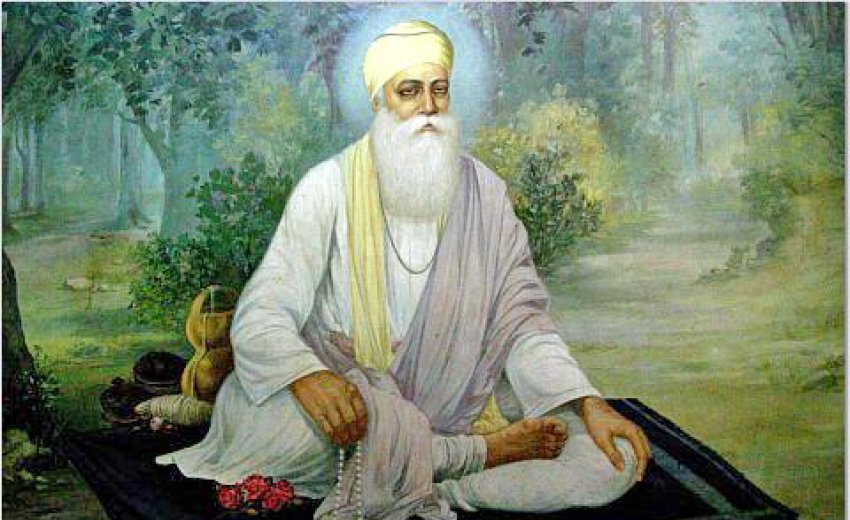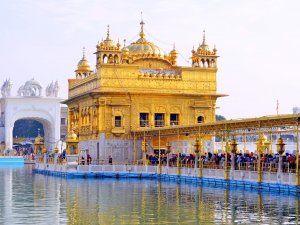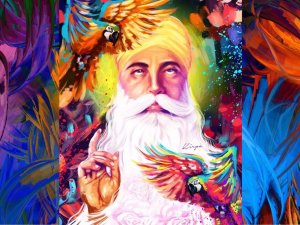Vaisakhi – Guru Nanak’s Birth Day
Through much of Sikh history and the Sikh world, Vaisakhi (April 1469) has been recognized as the Day of Celebration for Guru Nanak’s birth. On this day, Nanak was born to his parents, his father Kalyan Chand Das Bedi, popularly shortened to Pita Kalu and his mother, Mata Tripta.
There has been no eye-witness record of the date of Guru Nanak’s birthday. However, Gyan Ratnavali (1712) of Bhai Mani Singh and Mehma Parkash (1776) of Sarup Das Bhalla, recorded April as his date of birth. Further, recent historians have calculated Guru Nanak’s birthday from his death records.
 The date of Guru Nanak’s passing is inscribed on the stone memorializing his death, and it was recorded in other historical documents. The number of days Guru Nanak lived on this earth is also known. Bhai Santokh Singh, a highly learned Sikh biographer, recorded the total age of Guru Nanak as 70 years, five months and 7 days. From this data, the distinguished contemporary Sikh historian, Karam Singh, calculated Guru Nanak’s age from the date of his death and established mid- April as Guru Nanak’s birthday.
The date of Guru Nanak’s passing is inscribed on the stone memorializing his death, and it was recorded in other historical documents. The number of days Guru Nanak lived on this earth is also known. Bhai Santokh Singh, a highly learned Sikh biographer, recorded the total age of Guru Nanak as 70 years, five months and 7 days. From this data, the distinguished contemporary Sikh historian, Karam Singh, calculated Guru Nanak’s age from the date of his death and established mid- April as Guru Nanak’s birthday.
Presently, prominent historians such as Giyani M.A. Macauliffe, Hew McLeod, Kahn Singh Nabha, Indu Bhushan Banerji, Khushwant Singh, Kirpal Singh, Ganda Singh, Harbans Singh, H.R. Gupta, Principal Satbir Singh, and others accept April as the date of the birth of Guru Nanak. Thus, April 2019 will be Guru Nanak’s 550th birth anniversary. The global Sikh community is preparing in various ways to celebrate this auspicious day.
However, Guru Nanak’s birth day is not the same as his Parkash day.
 At his birth, Guru Nanak’s destiny to spread Divine Wisdom was not recognized either by his parents or the community around him; with the possible exception of Rai Bullar who was the head administrator of the town where Guru Nanak was born.
At his birth, Guru Nanak’s destiny to spread Divine Wisdom was not recognized either by his parents or the community around him; with the possible exception of Rai Bullar who was the head administrator of the town where Guru Nanak was born.
The nine Gurus who followed Guru Nanak and the Guru Panth (Sikh community throughout the world) have traditionally celebrated Guru Nanak’s birthday on Vaisakhi in a variety of ways. The celebrations included spiritual services as well as the holding of conferences, teaching retreats, and launching of new books or other initiatives.
The Gurus, themselves, designated Vaisakhi day to meet and greet Sikh congregations from distant places and to inaugurate a variety of programs throughout their ministry.
Their ministry expanded for nearly two centuries. The Vaisakhi of Guru Gobind Singh remains the most memorable celebration today. Maharaja Ranjit Singh chose this day for his coronation which he celebrated at both Nanakana Sahib, Guru Nanak’s birthplace, and in Lahore in 1801.
Katik – Guru Nanak’s Parkash Day
Guru Nanak’s birthday contrasts with Guru Nanak’s Parkash Day that falls in the month of October-November (Katik or Kartik) on the full moon (pooranmashi) night.
The word Prakash is derived from the Sanskrit word “prakāśa”, literally meaning “Bright light” or “Sun light” or “Moonlight” or simply “Light.”
Bhai Gurdas, the Sikh theologian of the highest recognition in Sikh history described Guru Nanak Parkash in var 1, Pauri 27 by the following verses.
ਸਤਿਗੁਰ ਨਾਨਕ ਪ੍ਰਗਟਿਆ ਮਿਟੀ ਧੁੰਧ ਜਗ ਚਾਨਣ ਹੋਆ॥
ਜਿਉਂ ਕਰ ਸੂਰਜ ਨਿਕਲਿਆ ਤਾਰੇ ਛਪੇ ਅੰਧੇਰ ਪਲੋਆ॥
ਸਿੰਘ ਬੁਕੇ ਮਿਰਗਾਵਲੀ ਭੰਨੀ ਜਾਏ ਨ ਧੀਰ ਧਰੋਆ॥
ਜਿਥੈ ਬਾਬਾ ਪੈਰ ਧਰੈ ਪੂਜਾ ਆਸਣ ਥਾਪਣ ਸੋਆ॥
ਸਿਧ ਆਸਣ ਸਭ ਜਗਤ ਦੇ ਨਾਨਕ ਆਦ ਮਤੇ ਜੇ ਕੋਆ॥
ਘਰ ਘਰ ਅੰਦਰ ਧਰਮਸਾਲ ਹੋਵੈ ਕੀਰਤਨ ਸਦਾ ਵਿਸੋਆ॥
ਬਾਬੇ ਤਾਰੇ ਚਾਰ ਚਕ ਨੌ ਖੰਡ ਪ੍ਰਿਥਮੀ ਸਚਾ ਢੋਆ॥
ਗੁਰਮੁਖ ਕਲਿ ਵਿਚ ਪਰਗਟ ਹੋਆ ॥੨੭॥
Satguru Nanak pragatai miti dhundhu jagi chananu hoa.
Jiu kar suraju nikalia tare chhapi andheru paloa.
Singh buke miragavali bhanni jai na dhir dharao.
Jithe baba pair dhari puja asanu thapani soa.
Sidhasani sabhi jagati de Nanak adi mate je koa.
Ghari ghari andari dharamsal hovai kirtan sada visoa.
Babe tare chari chaki nau khandi prithavi sacha dhao.
Gurmukhi kali vichi paragatu hoa.
Pauri 27 (Rise of Guru Nanak)
With the emergence of the Eternal Guru Nanak, the mist (metaphor for multiple factions toeing the religiosity by clergies) cleared and the light (true enlightening wisdom) sprinkled all around. As if at the sun rise the stars disappeared and the darkness dispelled. With the roar of the lion in the forest the flocks of escaping deer now cannot have endurance. Wherever Baba put his feet, a religious place was erected and established. All the worship places now have been renamed on the name of Nanak. Every home has become a place of dharma where singing to all four directions and nine divisions of earth. Gurmukh (Guru Nanak) has emerged in this kaliyug, the dark age.
In the case of Guru Nanak, the Parkash refers to the event when Guru Nanak’s inner Light manifested in his form and identity, initiating a period in history when the Pure Light of Universal Wisdom spread to the communities Guru Nanak visited and touched.
The event is described as below.
The Reference to Parkash Day of Guru Rank
In 1496, after a lifetime of spiritual curiosity, exploration, study and devotion, Guru Nanak entered a deep meditative trance where he experienced the truth of Creation. He saw the Cosmos, the Creator, and the human being intimately linked in a dance of learning and of consciousness. He was 27 years old.
The vision he received went beyond the ideology of any particular religious faith, but rather recognized that all people undertake a common journey in life. It was this commonality that ignited Guru Nanak’s heart. He developed a sovereign relationship with the Divine – directly hearing the Song of Universal Truth and sharing it in many different languages throughout his life.
At the time of his enlightenment experience, Guru Nanak was a 27-year old man, employed as a business manager of the store and the properties of one Daulat Khan, a Muslim, who was also the head of the town of Sultanpur Lodhi.
The Kali Vein River has been given a special historical significance in North India because it provided the venue where Guru Nanak experienced his enlightenment. The 160-kilometer long river springs from Dhanao village and merges in the confluence of the Beas and Ravi rivers. The base spring was considered holy by the local Dhanao people. Mogul Emperor Akbar (1542-1605) ordered it brick-lined for preservation and pilgrimage.
Halfway in the Kali Vein’s journey toward the confluence lies the town of Sultanpur Lodhi, an old Muslim settlement on the riverbanks, now regarded as sacred by the Sikhs. There in the town stands a gurdwara commemorating Guru Nanak’s spiritual awakening. Several other monuments in the town memorialize the Guru’s dialogues with the community of scholars and religious leaders. They are the evidence that Guru Nanak was the first among the religious leaders to initiate and popularized the interfaith dialogues.
The Guru visited the river daily for his bath and meditation in the early hours of the morning. After that, while on his way to work in town, he often visited with a Muslim holy man for a chat. It is during one of these early morning meditations that his awareness expanded and he communicated with the Creator. The story goes as follows.
One morning, Guru Nanak disappeared into the river and spent, it is said, three days in meditation. He re-emerged in a divine trance, reportedly, and as soon as he came out of that trance, he said he had a vision, a revelation. The revelation inspired him to teach the world that a Divine Presence permeates the universe. That religions were only man-made and should not be employed to profile and divide people. This reference was about Hindus and Muslim, the two major religions in the area.
It was the night of the full moon in November 1496 (some historians report the year to be 1499) that he emerged from his meditation.
The Day of Enlightenment as Parkash Day
The day of Guru Nanak’s enlightenment known as Guru Nanak’s Parkash Divas is celebrated every year. Thousands of devotee flock to the holy town of Sultanpur Lodi to pay their homage. In 2005, the President of India Dr. A.P.J. Abdul Kalam visited this memorial of enlightenment as it is called today, and in 2006 the Government of India, encouraging Indian tourists to visit this city, declared it a holy city to be preserved as part of the Sikh heritage.
On this day Guru Nanak began to claim in more than one way that the Creator had summoned him and assigned him the mission of sharing this divine message to all humanity. He claimed to have received the message directly from the ONE in a state of heightened consciousness, and he taught it to people by singing it in inspired hymns. There are many famous verses of his pronouncements including the commencing verse of Sri Guru Granth Sahib, popularly known as Mool Mantar. This hymn begins with a symbol to serve as Sikh insignia. The symbol of Ek Onkaar is popularly translated as the One Reality (Force) that is manifested in all creation.
The Guru said that he would transcribe the divine message for people of all times. The formal pronouncement of his mission startled the town’s people, although they had known him as a spiritually enlightened person. Those vested in the old beliefs went to the authorities to complain that Nanak was claiming to be a new prophet.
When the town authorities heard complaints against Nanak, the town’s head Daulat Khan summoned him for a high-level dialogue. Khan also invited his chief religious’ advisor, a Muslim Imam, leading a group of imams and other Muslim scholars, to interrogate Nanak about his prophetic experience.
A public debate took place, taking almost a week to conclude. Many questions were asked, many issues were raised. Guru Nanak answered them all and made many pronouncements during the dialogue.
At the end of the dialogue-meeting, much to the Imam’s befuddlement, Khan declared that Nanak had indeed received a divine vision and had been given the responsibility and authority to share that vision with humanity.
The following excerpt taken from the oldest written record available describes Khan’s judgment:
ਤਬ ਕਾਜੀ ਹੈਰਾਨ ਹੋਇ ਰਹਿਆ – ਤਬ ਖਾਨੁ ਕਹਿਆ ਕਾਜੀ ਇਸ ਕਉ ਪੁਛਣਾ ਤਕਸੀਰ ਹੈ ਏਹੁ ਖਦਾਇ ਕਾ ਕੋਈ ਉਲੀਯਾ ਹੈ
The Imam, the chief interrogator, was wonderstruck. Then, Khan, the head of the town, told the Imam that further questioning would be arrogant, and declared that this person is an aulia (saint- prophet) of Khudaa (Islamic term for God). (B 40 Janamsakhi)
This public acknowledgment of Nanak as God’s messenger clearly earned him the title of the prophet or aulia in the Muslim tradition and the title of the Guru in the non-Muslim traditions of India.
Thus, the day Guru Nanak shared his divine vision and announced his mission to teach what he had learned became known and celebrated as Guru Nanak’s Parkash Day.
The Mission of Parkash Day
The mission that Guru Nanak undertook that day was to engage the religious leaders of South East Asia and the Middle East in dialogue to define a truly Universal, human path of truthfulness. A path that would cultivate both a successful life and spiritual achievement. It is then that Guru Nanak advanced three core values to live by. These core values became the central theme in his wide-ranging missionary endeavors.
Guru Nanak designated three core values that, when blended, would transform life into something perfect. In doctrinal terms, Guru Nanak named them NAAM, DAAN, ISNAAN. Translated into today’s idiom, they are:
NAAM – Mindful Awareness of the Creator’s Presence within oneself and within all of Creation.
DAAN – Receiving what the Creator gives (materials of livelihood and virtues of good human beings), and then sharing that with others.
ISNAAN – Self-cleansing – bathing to keep the body healthy and clean, and practicing good deeds to keep the mind healthy and clean, as well.
Mixing of Guru Nanak’s Birth Day and Parkash Day
There is no denying that over a period of time, the Sikh community has forgotten the distinction between the celebration of Guru Nanak’s birthday, and Guru Nanak’s Parkash Day. How did this happen?
How Did Parkash Day Come to be Celebrated
Until the time of Maharaja Ranjit Singh (1780 –1839), only Guru Nanak’s human birthday was celebrated both at Nankana Sahib and other towns with significant Sikh populations. It always occurred in the middle April at the time of harvest and other Hindu religious festivals. These events divided the Indian population and the attendance at the major gurdwaras was scanty. The Sikh clergy were always on the lookout to find an occasion when the community might be exclusively attracted to sacred Sikh places, particularly at Amritsar. The story goes as follows.
There lived in the time of Maharaja Ranjit Singh, Bhai Sant Singh Giyani, who was held in high estimation by the monarch and who lived in Amritsar. Bhai Sant Singh would search for ways to bring Hindus and Sikhs to Amritsar for a celebration after they sold their crops and had plenty of money in their pockets. That period was usually around Diwali which is Hindu new year.
Some five miles from Amritsar is an old lake called Ram Tirath. It is a pilgrimage place of Lord Ram for the Hindu community. At that place, a Hindu fair was and still is held at the time of the full moon in the month of Kartik. All the monetary donations from the earnings of the people would go to that place.
The pilgrimage place is essentially Hindu, and it had the further demerit in the eyes of Bhai Sant Singh of having been restored by Lakhpat, the prime minister of Zakaria Khan, the inhuman prosecutor of the Sikhs.
Bhai Sant Singh desired to establish a competitive fair in Amritsar on the same date, and to divert the Hindus and Sikhs from making the pilgrimage to Ram Tirath. To that end, he adopted the Handali date of Guru Nanak’s Parkash and proclaimed that his new fair at Amritsar on the full moon in the month of Kartik was to honor the nativity of Guru Nanak. It is recorded that Bhai Sant Singh obtained both permission and patronage from Maharaja Ranjit Singh to do so.
Conclusion
In conclusion let us summarize Giyani Max Arthur Macauliffe at the Guru Nanak PArkash issue. There is no doubt that Guru Nanak was born in Vaishakh month. All the older Janamsakhis give that as Guru Nanak’s natal month. As late as the Sambat 1872 it was in Baisakh that the anniversary fair of Guru Nanak’s birth was always celebrated at Nankana. And finally, the Nanak Parkash gives the full moon in Kartik Sambat 1526, as the time of Guru Nanak’s Enlightenment or Parkash; and the tenth of the dark half of Assu, Sambat 1596, as the date of his death. The Nanak Parkash states that he lived seventy years five months and seven days. This total is irreconcilable if one equates the Parkash date with Guru Nanak’s physical birthday. But the total is very nearly reconcilable with the date of the Guru’s birth given in the old Janamsakhi. ” (Max Arthur Macauliffe, The Sikh Religion, first edition 1909CE, reprinted by Low Price Publications. Delhi 1996 p.lxxxiv.).
Thus, the month of April is Guru Nanak’s birth month and the month of October-November is when Guru Nanak’s Parkash or enlightenment recognized.
The Parkash Day of Guru Nanak was the day when Guru Nanak began to share the Divine Vision he received during his enlightenment with others, and a new Light began to shine in the world. It is then that Guru Nanak began to impact humanity and the stories of that impact began to be told for posterity.
Useful References:
* Kirpal Singh , Janam Sakhi Parampara. Patiala : Punjabi University, 1969
* Harbans Singh, Ed., Encyclopedia of Sikhism, Vol.1. Patiala: Punjabi University, 1992.
* Khushwant Singh, A History of Sikhs, Vol.1. New Delhi: Oxford University, 1999.
* McLeod, W. H. Ed., The B40 Janam-Sakhi. Amritsar, GNDU, 1980.
* Harbans Singh, Guru Nanak and the Origins of the Sikh Faith. Delhi: Asia Publishing House, 1969.
* Max Arthur Macauliffe, The Sikh Religion, first edition 1909CE, reprinted by Low Price Publications. Delhi 1996.






